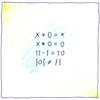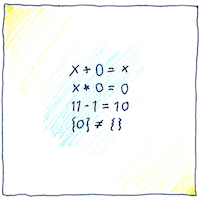Brahmagupta
mathematics

|
Zero
Brāhmasphuṭa-siddhānta (“Correctly Established Doctrine of Brahma”) by Brahmagupta is the first known text to describe how to use zero as a number. It covers addition, subtraction, multiplication, and division with zeros and whether the result is positive or negative. Brahmagupta also gave rules for solutions to general linear equations, for calculating roots, powers, and sums of powers, for handling fractions, for calculating Pythagorean triples, for calculating the area of cyclic quadrilaterals, and for the value of π.
Zeros
The Chinese used a space in their counting-rod system as a placeholder for zero. The Incans used the absence of a knot in their knotted cord device. The Babylonians had a symbol used as a placeholder in other numbers, to distinguish, for example, 105 from 15. So did the Olmecs in Mesoamerica in the numeral system for their long-count calendar. Ptolemy and the Romans had a symbol for the lack of a quantity, but they did not perform arithmetic with it. Mathematicians in India used the the Sanskrit word “ś ūnya” to refer to zero or void. For Brahmagupta, zero is a positive number; today we say it is neither positive nor negative. For Brahmagupta, a fraction could have a zero denominator; today we say division by zero is undefined. Brāhmasphuṭa-siddhānta was translated into Arabic by 1050. The Arabic word ŝifr gives us our words “zero” and “cipher.”
Something
Zero is nothing but nothing itself, the same as the empty set. The empty set is a subset of all other sets, including the empty set, which is probably not why seeing the emptiness in everything is a key to spiritual enlightenment. A photon is the zero of elementary particles; it’s a mass of nothing whose energy is all in its frequency. To reply “empty handed” is not an empty reply; it’s better than not replying. There is only one empty set, nothing being the same in all circumstances. Really, no response is the same as no banana.
Nothing
For the time being, I enjoy my temporary existence loving many who are here and many who are gone, and it makes me think how close we are to nothing at all.



We make a distinction between 0, the number of nothing, and 0, a digit that is used in numbers written with digits in our positional number system.
History shows that the digit 0 came first (using various symbols). The history of the number 0 came from Brahmagupta. The Islamic world already had the positional number system. Brahmagupta gave them the number 0. The Persian, Muḥammad ibn Mūsā al-Khwārizmī (the inventor of algebra), oversaw translation of Brahmagupta into Arabic. Al-Khwārizmī’s work in Latin translation in the twelfth century introduced the Hindu-Arabic numeral system to the Western world. Fibonacci, having learned from Arabic mathematicians, contributed to its adoption in the thirteenth century.
See also in The book of science:
Readings in wikipedia: